Medical expert of the article
New publications
Preparations
Ointments for allergic dermatitis
Last reviewed: 07.07.2025

All iLive content is medically reviewed or fact checked to ensure as much factual accuracy as possible.
We have strict sourcing guidelines and only link to reputable media sites, academic research institutions and, whenever possible, medically peer reviewed studies. Note that the numbers in parentheses ([1], [2], etc.) are clickable links to these studies.
If you feel that any of our content is inaccurate, out-of-date, or otherwise questionable, please select it and press Ctrl + Enter.
More and more people, regardless of age, suffer from increased reactivity of the immune system to agents that cause allergic conditions, including dermatitis.
Dermatitis is a response of the body that occurs from contact of the skin with various mechanical and chemical irritants or can be associated with an internal imbalance in the human body caused by metabolic disorders, hormonal disorders and gastrointestinal pathologies, in the form of localized inflammation of the skin.
The affected skin areas should be treated with medicinal ointments and creams. Therapy begins with less active drugs, and if there is no positive dynamics, they resort to potent drugs. To receive effective and adequate treatment, the patient must visit an allergist or dermatologist.
The doctor will determine the type of skin inflammation, find out the cause that caused it, prescribe tests and, based on the results of the studies, select the necessary drugs and ointments. Among the most common ointments, gels and creams: Bepanten, Radevit; Skin-Cap; Fenistil. Ointment forms may contain extracts of medicinal herbs, as well as components that have anti-inflammatory properties, relieve pain and promote rapid restoration of the normal condition of the skin.
 [ 1 ]
[ 1 ]
Release form
In the treatment of dermatitis of allergic origin, it is recommended to use suspensions, creams, ointments, gels consisting of an oil-fat base and various active substances (hormonal components, extracts of plant and animal origin).
Bepanten. Most often used in the following situations: allergic dermatitis, cuts, scratches, insect bites, dermatitis of various origins.
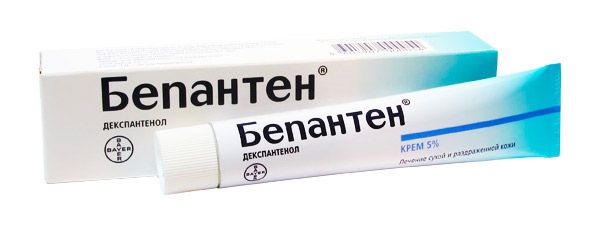
The cream is approved for use during gestation and lactation.
The only contraindication is individual hypersensitivity to the ingredients of Bepanthen.
The shelf life from the date of manufacture is 3 years, subject to the following storage conditions: dry, dark place, inaccessible to children; air temperature no more than 25°C.
Desitin is a cream whose active ingredient is zinc oxide. Recommended for: streptoderma, scratches, abrasions, ulcers, allergic dermatitis, herpes, eczema.
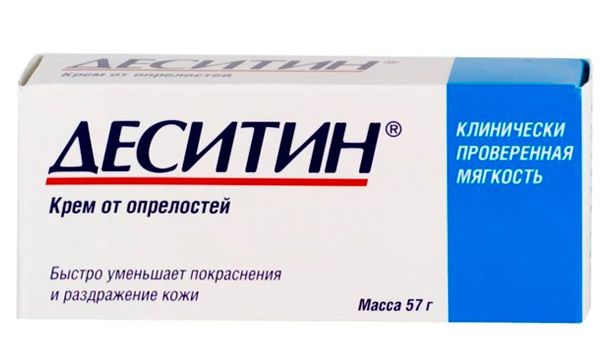
Losterin cream. Ingredients: dexpanthenol, phenolic acid, carbonic acid diamide, Japanese pagoda tree extract, almond oil, resin-free naphthalene. Recommended for: psoriasis, inflammatory pathologies of the epidermis, allergic dermatitis. Apply twice or three times a day to the affected skin. Its advantages are: non-hormonal, does not contain dyes or odors, does not cause addiction, is quickly absorbed, and is suitable for any skin type.
The duration of use of the cream (7-30 days) depends on the severity of the disease, the frequency of relapses, and the characteristics of the body. Breaks between therapy cycles depend on the stabilization of the skin condition. It has antipruritic and antiphlogistic properties. The regenerative effect begins to manifest itself no earlier than after 1-1.5 weeks of treatment and is recorded only with cyclic use.
Sensitivity to some components of the cream is a reason to refuse its use.
Side effects are very rare (slight burning at the site of application of the drug). The shelf life from the date of manufacture is 24 months.
Naftaderm is a 10% liniment. It contains naphthalan oil, which has antiphlogistic and analgesic effects in dermatological diseases (atopic dermatitis, eczema, furunculosis, etc.).

Contraindications: individual sensitivity to the ingredients of the liniment, diseases of the excretory system, hemorrhagic vasculitis, various anemias.
The liniment is approved for use during gestation after being prescribed by a doctor. There are virtually no side effects.
It is used externally. Apply a thin layer to the affected areas twice a day with light movements, without rubbing. The duration of therapy is strictly individual, usually from 3 weeks to 1 month. If dryness and peeling of the skin occurs, you can lubricate it with a softening cream or interrupt the procedures for several days. If Naftaderm is used to treat a child, it is necessary to listen to the opinion of a specialist.
Shelf life is 48 months. For storage, a dry place inaccessible to sunlight with an air temperature of 4-8 °C is required.
Protopic. Ointment. Active ingredient - tacrolimus. Used in the treatment of diffuse neurodermatitis in childhood, has an antiseptic and antiphlogistic effect; white or yellowish, homogeneous structure without inclusions.
Pharmacodynamics. Tacrolimus slows down the function of calcineurin. It reacts with immunophilin, which is an intracellular protein for calcineurin. This reaction slows down the phosphatase activity of calcineurin. Tacrolimus ointment does not affect the production of fibrillar protein, so there is no depletion of the deeper layers of the skin.
Pharmacokinetics. When used locally, tacrolimus is practically not absorbed into the systemic bloodstream. The active substance does not accumulate in the body during prolonged use. Due to low absorption, the ability to react with plasma proteins in the bloodstream is insignificant. A small amount of tacrolimus that enters the bloodstream is metabolized by the liver. Tacrolimus does not accumulate in the epidermis.
Hypersensitivity to the ingredients of the ointment; gestation period; lactation period; Netherton syndrome are contraindications for use.
The product is applied externally to the affected areas of the skin. If it gets on the mucous membranes, rinse thoroughly with boiled water at room temperature. Do not use as ointment dressings. Prescribed with special caution in patients with decompensatory liver failure, with significant skin lesions, children under 3 years of age, especially when using long courses.
The shelf life of the ointment is 3 years, subject to the storage conditions recommended by the manufacturer (dry, dark room with a temperature of no more than 25 °C). It is not recommended to use after the expiration date indicated on the factory packaging.
Radevit is a combination ointment. It has antiphlogistic and regenerative effects. Reduces itching, softens and saturates the upper layers of the epidermis with moisture; stabilizes keratinization processes and increases the protective functions of the epidermis. Ingredients: 10 mg of retinol, 5 mg of tocopherol, and 50 mg of ergocalciferol.
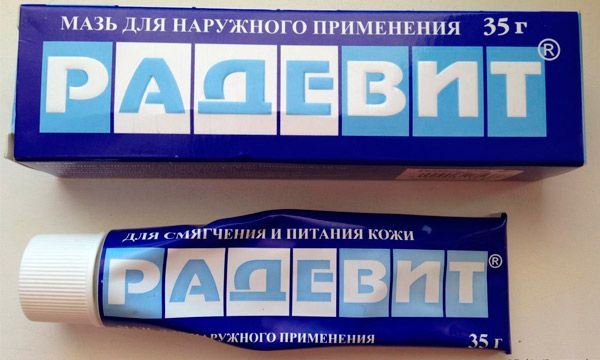
The ointment does not contain hormones. Indications for use are: allergic dermatitis, cracks, erosions of the upper layers of the epidermis, disseminated neurodermatitis.
Radevit is applied to the affected area twice a day; in case of severe erythroderma of the skin, an airtight dressing is used. Before applying Radevit to microcracks, abrasions and other defects of the skin, they are subjected to antiseptic treatment. Contraindications - increased sensitivity to the ingredients of the ointment; hypervitaminosis A, D, E in the body; in dermatitis in the acute period (possibly increased local symptoms, hyperemia and itching); during gestation; during the lactation period. Do not use synchronously with tetracyclines and corticosteroids, which reduce the effectiveness of the ointment.
Store the ointment in a dry, dark place at a temperature of 4-10°C. Do not freeze. Radevit has a shelf life of 48 months.
Skin-Cap is produced in the form of a cream or gel with antifungal, bactericidal, antiphlogistic, and antiproliferative properties.
Indicated for use in: dermatitis of various origins, erythema of the buttocks in newborns, psoriasis, eczema, neurodermatitis, dryness and flaking of the upper layers of the epidermis, oily and dry seborrhea.
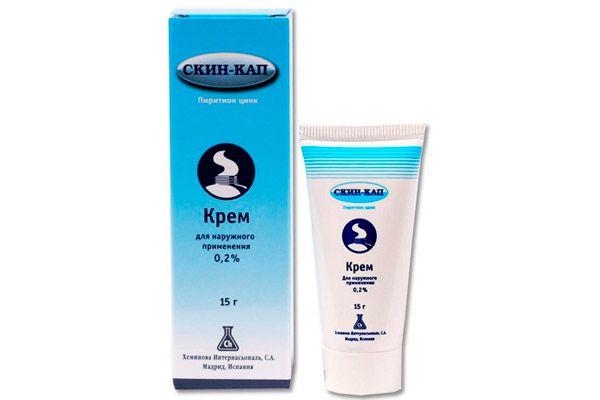
Pharmacodynamics. The drug has a property that inhibits the growth of bacteria. The antifungal focus of the drug concerns Pytyrosporum ovale Pytyrosporum orbiculare, which are the cause of inflammation and excessive peeling in psoriasis and other dermatological diseases.
Zinc pyrithione inhibits epithelial proliferation, reduces flaking in psoriasis and other dermatological diseases.
Pharmacokinetics. Zinc pyrithione can accumulate on skin areas when applied externally, but systemic absorption into the bloodstream almost does not occur, so traces of the substance can be found in the blood. Recommended for use in children from 1 year of age.
Method of application – externally. Apply a thin layer 2 times a day. The course of therapy for diffuse neurodermatitis is 3-4 weeks. The duration of therapy depends on the nature of the disease, the degree of severity and the extent of skin manifestations.
The cream is suitable for use for 3 years if the storage conditions are observed - in a dark, dry place inaccessible to children at a temperature of 4° to 20°C.
Thymogen is an immunomodulatory cream that relieves itching and hyperemia in atopic dermatitis and long-term eczemas. It should be prescribed with caution, especially to children. Any immunostimulant is used only as prescribed by a doctor.
The active ingredient is Alpha-glutamyl-triptophanum in the form of sodium salt. Fillers: liquid paraffin, polysorbate 60, petrolatum, 1,2,3-propanetriol, xanthan gum, propyl parahydroxybenzoate, purified water, etc.
0.05% white or white with yellowish color.
The cream is applied externally. According to the instructions, the daily dose is 2 g of cream (applied morning and evening to the affected areas without rubbing or covering with a bandage). Duration of therapy - until local manifestations of the disease are reduced, but not more than 20 days. Contraindications: hypersensitivity to the components and active ingredients of the cream.
Thymogen is not used during pregnancy and breastfeeding. No cases of Thymogen overdose have been observed. Experimental data indicate that the drug is not toxic.
Shelf life: 24 months. Refers to potent drugs. The following conditions are required for storing the cream: inaccessible to children, protected from light, with an air temperature of 2° to 20°C.
Fenistil (Fenistil) is a gel that is an antipruritic drug used to relieve local allergic reactions in dermatological diseases. Fenistil has a local analgesic effect in eczema, dermatitis, insect bites, and burns.
Consists of the active substance – dimethindene maleate; fillers – alkylbenzyldimethyl ammonium chloride, disodium salt, carbopol 974 P (carbomer 974 P), propylene glycol, caustic soda (30% w/w solution), purified water.
Available in 30g aluminum tubes with a synthetic polymer cap.
Fenistil has a homogeneous structure. Transparent gel, without a specific smell.
Thanks to the gel structure, it quickly has a therapeutic effect (symptom relief is felt within a few minutes), the maximum effect lasts for 1-4 hours.
Pharmacokinetics. It has good dermal penetrating properties at the local level. Systemic bioavailability is 10%.
In the first trimester (up to 14 weeks) of the gestation period, the gel is allowed strictly according to indications. From the 14th week of pregnancy until delivery, as well as during lactation, the drug is not used. It is not advisable to use on areas with large lesions, especially in the presence of inflammation or bleeding surface.
Fenistil is applied to the affected area two to four times a day.
When using Fenistil on large affected areas, it is necessary to avoid exposure to ultraviolet radiation. If there is no positive dynamics during therapy or if symptoms increase, it is necessary to consult a dermatologist.
It is necessary to store under standard conditions for ointments and creams and at a temperature not exceeding 25 °C. If the storage conditions are observed, the shelf life is 36 months. Do not use after the expiration date.
Exoderil is an antifungal cream used for dermatitis of unknown etiology. Indications for its use are fungal skin lesions, shingles and allergic dermatitis.
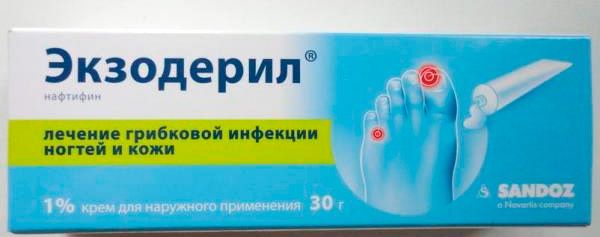
The ointment form of the drug is used locally, externally. The drug is applied to clean, dry skin. Lubricate the affected areas, capturing a little healthy skin.
The duration of therapy and frequency of skin treatments are determined by the doctor individually.
Typically, the ointment is used once a day, applying a thin layer and rubbing into the skin until completely absorbed.
When used locally during pregnancy, it does not cause embryonic disorders. During gestation, the drug can be used if the expected benefit to the mother exceeds the possible risk to the fetus, which is determined by the doctor. The drug is used with caution during lactation.
Shelf life: 70 months.
Eplan is a cream. Application: psoriasis, eczema, herpes, acne, mild burns, itching, dermatitis of various origins, insect bites, as protection against chemically aggressive agents. The preparation effectively promotes wound healing and skin regeneration. It has an antiseptic, analgesic, and dermatoprotective effect. This prevents infections and accelerates recovery from thermal and chemical burns. It is based on lanthanum salts, polyalcohol, and simple carbohydrates without antibiotics, hormones, and analgesics.
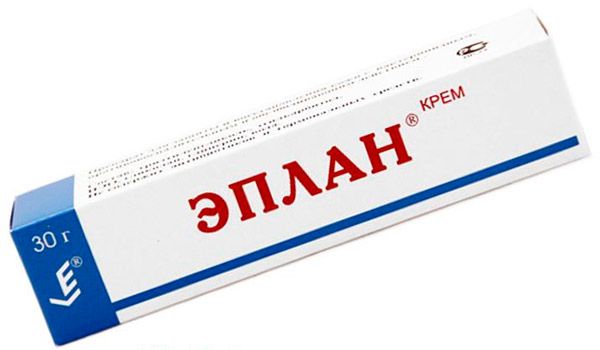
It has no pronounced side effects. There are no contraindications for long-term use. It is not toxic.
Contraindications - hypersensitivity to individual ingredients. Apply the product several times a day to the affected areas until the healthy skin is completely restored.
Shelf life is 70 months.
Ointment for allergic dermatitis on the face
Allergic dermatitis is manifested by hyperemia, accompanied by peeling and itching. A person experiences not only physical but also psychological discomfort. Therefore, it is necessary to consult a dermatologist to prescribe adequate treatment.
The disease has 3 stages:
- Acute. The following are noticeable on the face: hyperemia, swelling, spots and blisters with serous contents, a feeling of tightness of the skin, burning.
- Subacute. The blisters burst, crusts form in their place, the skin becomes dry and flaky, and itching appears.
- Chronic. In the absence of timely complex treatment, the disease is difficult to treat. The process is subject to seasonal relapses. Dermatoses in the chronic stage are accompanied by peeling of the upper layers of the epidermis, dry skin and its lichenification. In such cases, it is better to apply ointment forms of drugs and creams to the skin. If the process has an acute course with a vesicular form, edema and oozing, then lotions and aerosols are used. For the scalp, facial skin, natural folds, aerosols and lotions that do not contain a fat base are used.
Videstim. It is used for: dermatitis, eczematous manifestations, cheilitis, abrasions and microcracks. The active substance is retinol palmitate (vitamin A), which stimulates skin regeneration and slows down keratosis. Excipients and fillers included in the ointment: emulsion wax, liquid paraffin, butylhydroxyanisole, ethanol 95% (solution), propane-1,2,3-triol, purified water, etc.
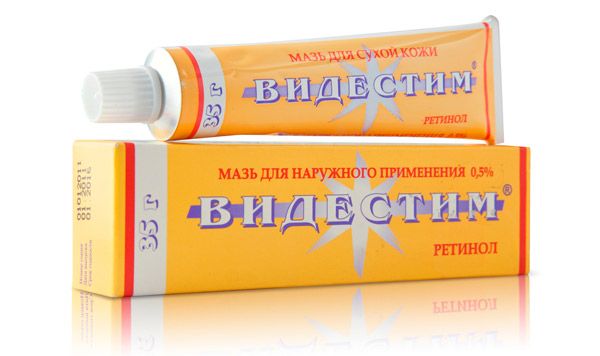
Videstim is produced as an ointment form of homogeneous structure, white or yellowish hue, packaged in 35 g aluminum tubes with a cap made of synthetic polypropylene. One tube and instructions for use are placed in the factory cardboard packaging.
Pharmacodynamics. The ointment stimulates the process of increasing the number of epithelial cells, thereby restoring epithelial tissue in deeper layers and preventing the progression of keratosis. Minor doses of retinol are absorbed by the skin and penetrate into the bloodstream.
Indications for the use of the ointment are: eczematous manifestations, allergic dermatitis, shallow abrasions, microcracks in the upper layers of the epidermis.
Contraindications to the use of the ointment are: hypersensitivity to retinol derivatives, additional ingredients; hypervitaminosis of vitamin A; inflammation of the skin in the acute stage.
Side effects - redness, fresh rashes. If the above symptoms appear, you should stop using the product.
Before using Videstim, you must carefully read the instructions for use of the ointment.
Directions for use. Apply to the affected skin area twice daily using the application method. The ointment quickly penetrates the upper layers of the epidermis. The active substance reaches maximum activity within 3 hours after application and remains effective for 12 hours.
Interaction with other drugs. Do not use Videstim synchronously with medications that contain retinoids, since the additive effect of their use leads to hypervitaminosis of vit. A. Simultaneous use of Videstim and drugs that contain tetracycline is also undesirable. Videstim ointment can be purchased in pharmacy chains without a prescription.
Overdose. No signs of overdose were observed during the use of the ointment.
Videstim is stored in a place inaccessible to direct sunlight, with a temperature regime from +2 to + 8 °C. The drug is valid for 5 years from the date of its production.
Retinoic ointment (0.05% and 0.1%) - dermatoprotective, antiseborrheic, softening, antiphlogistic agent. The active ingredient is tretinoin (retinoic acid). Tretinoin is a derivative form of vitamin A, involved in the regulation of cell proliferation, inhibiting excessive secretion of the sebaceous glands, promoting regenerative processes in the skin.
Side effects: hyperemia, swelling and the appearance of fresh rashes. It is not recommended to use on large lesions; for women planning pregnancy; during gestation; during breastfeeding. Patients taking drugs containing retinoids are not recommended to prescribe the ointment. Patients with a history of chronic kidney, liver, pancreas diseases, in the presence of heart failure, the ointment is prescribed with caution.
Do not use Retinoic ointment together with preparations containing tetracycline antibiotics. The use of corticosteroid hormones reduces the effectiveness of the ointment.
Dosage and method of administration. Externally, in the form of applications, apply to the affected areas of the skin twice a day. The duration of the course of therapy is from 1 to 3 months.
Special instructions. The ointment is not used on the skin around the eyes, in case of inflammatory processes in the active stage of exacerbation. Retinoic ointment is not applied to mucous membranes.
According to the instructions, the storage conditions for the drug are as follows: a dark, dry room with an air temperature of 2-8 ° C. Do not freeze.
The shelf life of the drug is 24 months. The production and expiration dates are indicated on the packaging. Do not use after the expiration date indicated on the packaging.
Ointments for contact allergic dermatitis
Allergic contact dermatitis is an inflammatory disease of the upper layers of the epidermis caused by direct exposure to allergens.
The disease can be caused by direct skin contact with various items containing nickel (costume jewelry, items with metallic nickel-containing coating, buttons, coins, hair dye and some food products, etc.), latex (shoes, gloves, baby pacifiers and nipples, anesthetic, drainage products, infusion systems, inhalation masks, etc.), medications, household chemicals, etc. A chemical substance, getting on the skin, causes its irritation and provokes an allergic reaction, manifested by inflammation. Like other allergic reactions, contact dermatitis occurs only in people predisposed to this disease, hypersensitive to certain substances. The main symptoms of contact allergic dermatitis are reddening of the skin, itching, vesicles with serous contents, erosions. For successful treatment of this disease, it is necessary to exclude contact of the allergen with the skin; use of antiphlogistic ointments; antihistamines.
If skin inflammation or erosion occurs, it is necessary to use ointments containing corticosteroids that help reduce inflammation - Lokoid, Advantan, Elidel and others.
Elidel cream - has antiphlogistic properties. It is used to treat: atopic, allergic dermatitis, eczema. The main active ingredient is pimecrolimus.
The product is recommended for use when the initial symptom complex of eczema appears. It helps prevent the worsening of clinical manifestations. The cream is gently rubbed into the affected areas of the skin in the morning and evening with light massage movements. If there is no positive dynamics within 1.5 months, then the patient is re-examined by a dermatologist or allergist to clarify the diagnosis. The duration of the course of treatment is determined by a specialist.
If the cream accidentally comes into contact with mucous membranes, rinse them thoroughly with water.
Contraindications - Elidel should not be used in children under three years of age, as well as in the following cases: dysplastic and destructive skin neoplasms, with possible malignancy; lesions of the upper layers of the epidermis by infections of various origins (viruses, fungi, bacteria); increased sensitivity to ascomycin and auxiliary ingredients of the cream; lamellar ichthyosis; generalized exfoliative dermatitis; immunodeficiency states.
Use of the cream during pregnancy. Elidel can be prescribed during gestation, but only after consultation with a specialist. The potential risk to the unborn child is minimal. During clinical studies, no teratogenic effects of the cream on the fetus were detected.
Interaction with other medicinal products. Due to the very low penetration of the active ingredient, systemic absorption is unlikely. Elidel does not affect immune responses after vaccination. Application to the vaccination site is contraindicated. To avoid negative interactions with components of other drugs, Elidel should be used at different times.
Storage conditions. According to the instructions, Elidel should be stored in a tightly closed tube, in a dark, dry room with an air temperature of no more than 25 °C. Freezing is not allowed.
The shelf life is about 2 years. When the tube is opened, the preparation is suitable for use for 12 months.
Advantan. The drug has a local antiphlogistic effect, helps reduce the manifestations of allergic reactions, slows down hyperproliferation. Due to the above properties, it has a positive effect on the upper layers of the epidermis, eliminating redness, thickening of the skin, swelling, rashes, itching and burning.
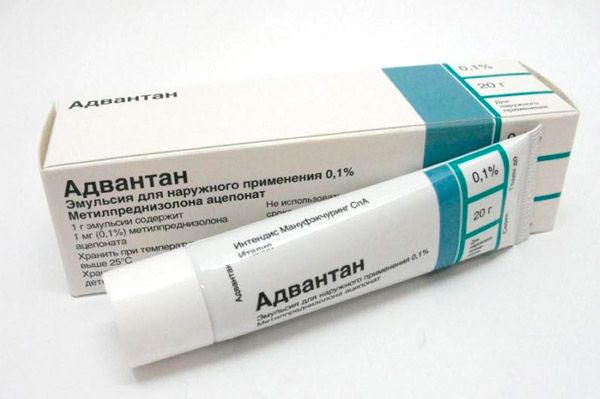
Indicated for use in: allergic, contact, atopic dermatitis, as well as neurodermatitis and eczema.
Apply by application to the affected areas once a day. Standard course of treatment is 3 to 5 days. Long-term use of the ointment is not recommended.
Ointment for contact allergic dermatitis
In childhood, at the first signs and manifestations of allergic dermatitis, lotions and occlusive dressings with a 1% solution of tannin, rivanol 1:1000, or freshly brewed black tea are used, followed by the application of zinc-containing pastes, ointments, and liniments for 5-7 days.
In case of acute inflammation with infiltration and hyperemia, it is recommended to use pastes and ointments that have antiphlogistic and keratoplastic effects (naphthalan, salicylic, resorcinol, ichthyol, solcoseryl).
If a secondary bacterial infection occurs, it is necessary to use ointments with antibiotics (lincomycin, ruzam, fucidin).
In the absence of positive dynamics, local application of corticosteroid ointments is indicated, which have antiphlogistic, membrane-stabilizing, vasoconstrictive and antiproliferative properties.
Use ointments for allergic dermatitis during pregnancy
The most important task of treating allergic dermatitis during gestation is to relieve itching, stop manifestations of inflammatory processes and hyperemia. During pregnancy, it is necessary to use the most gentle medications that will not have a negative impact on the health of the mother and the unborn child. Doctors often recommend ointment forms of drugs, creams, gels containing steroids.
The pharmaceutical industry produces a wide range of ointment forms of drugs (pastes, gels, creams and ointments), from which you can choose the most effective remedy in each specific case.
In addition to medicinal preparations, it is necessary to use products with moisturizing, softening effects, which are used several times a day to prevent dryness and flaking of the skin. Moisturizing lotions and soap substitutes (shower gels, foams, cream soap) also have a positive effect, reducing irritation and itching. Frequent water procedures are not desirable, because this provokes dry skin.
To relieve symptoms, steroid creams or ointments are prescribed. They are applied to the affected areas of the skin. Hydrocortisone acetate preparations or halogenated glucocorticoid creams of medium concentration can be used. The product should be used in minimal quantities. Ideally, one or two small tubes.
Antibiotics may be prescribed during therapy due to eczema becoming infected with bacteria.
Strong steroid creams and ointments have a teratogenic effect if used in significantly higher doses and quantities. Children in such cases may be born underweight.
Any therapy should begin with a medical consultation.
Attention!
To simplify the perception of information, this instruction for use of the drug "Ointments for allergic dermatitis" translated and presented in a special form on the basis of the official instructions for medical use of the drug. Before use read the annotation that came directly to medicines.
Description provided for informational purposes and is not a guide to self-healing. The need for this drug, the purpose of the treatment regimen, methods and dose of the drug is determined solely by the attending physician. Self-medication is dangerous for your health.

